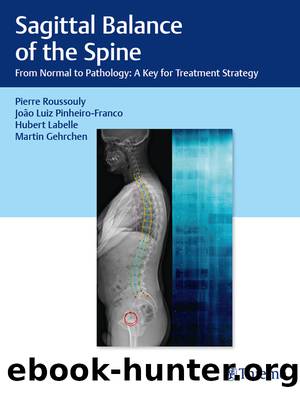Sagittal Balance of the Spine by Roussouly Pierre;Labelle Hubert;Pinheiro-Franco Joao Luiz;

Author:Roussouly, Pierre;Labelle, Hubert;Pinheiro-Franco, Joao Luiz;
Language: eng
Format: epub
Publisher: Thieme Medical Publishers, Incorporated
Published: 2019-08-15T00:00:00+00:00
Fig. 12.19 What to reduce: first the L5-S1 kyphosis, then partial slip grade reduction.
Fig. 12.20 Case example of a slip reduction in high-grade spondylolisthesis (HGS).
12.8 Conclusion
Global sagittal plane alignment is important to consider in both adult and pediatric patients with L5-S1 spondylolisthesis. Clinicians treating this disorder need to be aware that normal sagittal balance of the hip-spinopelvic axis is frequently disrupted and that it is insufficient to limit their evaluation and base their treatment plan strictly on the local L5-S1 area. Abnormal spinopelvic alignment alters the biomechanical stresses at the lumbosacral junction, and compensation mechanisms are developed to maintain an adequate posture. A classification based on sagittal alignment is proposed to help treatment decisions.
In patients with HGS associated with a postural abnormality, it is important to reduce and realign the spinal deformity, thus restoring global spinal alignment and improving the biomechanical environment for fusion. Recent evidence 26,â27,â28,â29 supports the contention that reduction of HGS improves overall global hip-spinopelvic balance by correcting the local kyphotic deformity and partly reducing vertebral slippage, and that reduction is not associated with a greater risk of developing neurologic deficits compared with arthrodesis in situ.
Download
This site does not store any files on its server. We only index and link to content provided by other sites. Please contact the content providers to delete copyright contents if any and email us, we'll remove relevant links or contents immediately.
| Anesthesiology | Colon & Rectal |
| General Surgery | Laparoscopic & Robotic |
| Neurosurgery | Ophthalmology |
| Oral & Maxillofacial | Orthopedics |
| Otolaryngology | Plastic |
| Thoracic & Vascular | Transplants |
| Trauma |
Periodization Training for Sports by Tudor Bompa(7937)
Why We Sleep: Unlocking the Power of Sleep and Dreams by Matthew Walker(6376)
Paper Towns by Green John(4815)
The Immortal Life of Henrietta Lacks by Rebecca Skloot(4271)
The Sports Rules Book by Human Kinetics(4087)
Dynamic Alignment Through Imagery by Eric Franklin(3931)
ACSM's Complete Guide to Fitness & Health by ACSM(3832)
Kaplan MCAT Organic Chemistry Review: Created for MCAT 2015 (Kaplan Test Prep) by Kaplan(3812)
Introduction to Kinesiology by Shirl J. Hoffman(3633)
Livewired by David Eagleman(3541)
The River of Consciousness by Oliver Sacks(3425)
The Death of the Heart by Elizabeth Bowen(3350)
Alchemy and Alchemists by C. J. S. Thompson(3305)
Descartes' Error by Antonio Damasio(3170)
Bad Pharma by Ben Goldacre(3113)
The Emperor of All Maladies: A Biography of Cancer by Siddhartha Mukherjee(2941)
The Gene: An Intimate History by Siddhartha Mukherjee(2934)
The Fate of Rome: Climate, Disease, and the End of an Empire (The Princeton History of the Ancient World) by Kyle Harper(2884)
Kaplan MCAT Behavioral Sciences Review: Created for MCAT 2015 (Kaplan Test Prep) by Kaplan(2827)
